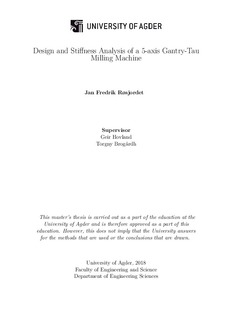| dc.description.abstract | The Gantry-Tau is a Parallel Kinematic Machine (PKM) structure that possesses many advantages
as a milling machine, where it has a low moving mass, high stiffness and a large workspace to
footprint ratio. This thesis presents a new milling machine design based on this structure, as a
continuation of a formerly constructed prototype, see [1]. This includes selection of new actuators
for the linear drives as well as the development of a new tool platform and two joint concepts. A
short workspace analysis is presented on the proposed design, which includes calculation of valid
workspace and an analysis on the required joint mobility with "optimal" joint mounting positions.
The machine stiffness in the entire workspace, with only links considered, is presented and stiffness
including the tool platform and gantry carriages is presented at five positions. A short analysis on
machine stiffness with 5-axis motion with tool rotation up to 25 degrees is also presented.
The proposed design of the machine is capable of reaching the demands of the milling application,
where it can handle feed forces above 1000N and move at linear speeds above 0.5m/s and rational
speeds above 1.5rad/s.
Simulations showed that the two joint concepts, a ball joint and Cardan joint design, have stiffness
in excess of 144 N/μm and 152 N/μm, at a weight of 2.1kg and 3.5kg. With these, the obtained
workplace stiffness is above 3.16N/μm, 4.42N/μm and 4.05 N/μm in x,y and z-direction with
3-axis motion and only considering link stiffness, which is >255% of the old design.
The new platform design increased the lowest recorded stiffness from 0.49N/μm to 83N/μm, with
a weight increase from 6.5kg to 16.6kg. Including tool platform and gantry drives, the workspace
stiffness is reduced by 11-21% within the 5-axis workspace.
The design was modelled with the use of SolidWorks (CAD software), and the stiffness was evaluated
with Abaqus (FEM software). Kinematics and machine stiffness calculations were performed with
Matlab.
i | nb_NO |

